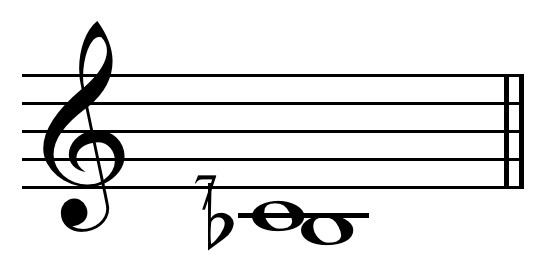Inverse Septimal major second Semitones ~9.7 Just interval 7:4 | Abbreviation m7 Interval class ~2.3 | |
 | ||
Other names Septimal minor seventh, Subminor seventh | ||
The harmonic seventh interval play , also known as the septimal minor seventh, or subminor seventh, is one with an exact 7:4 ratio (about 969 cents). This is somewhat narrower than and is, "particularly sweet," "sweeter in quality" than an "ordinary" minor seventh, which has a just-intonation ratio of 9:5 (1017.596 cents), or an equal-temperament ratio of 1000 cents (25/6:1). The harmonic seventh may be derived from the harmonic series as the interval between the seventh harmonic and the fourth harmonic (octave of the fundamental).
This note is often corrected to 16:9 (B♭-, 996.09 cents) on the natural horn in just intonation or Pythagorean tunings, but the pure seventh harmonic was used in pieces including Britten's Serenade for tenor, horn and strings.
Composer Ben Johnston uses a small "7" as an accidental to indicate a note is lowered 49 cents (1018-969=49), or an upside-down "7" to indicate a note is raised 49 cents. Thus, in C major, "the seventh partial," or harmonic seventh, is notated as ♭ B with "7" written above the flat.
Some theorists believe that the harmonic seventh is also used by barbershop quartet singers when they tune dominant seventh chords (harmonic seventh chord), and is an essential aspect of the barbershop style; however this claim was not supported by the empirical data of Hagerman and Sundberg (1980), and the failure of other psychological studies on intonation to find evidence for the harmonic seventh casts doubt on its musical or psychological existence. Instead, Hagerman and Sundberg found that tuning of major and minor third intervals in barbershop lies between just (4:5, 5:6) and equal temperament.
The harmonic seventh differs from the augmented sixth by 224/225 (7.71 cents), or about one-third of a comma. The harmonic seventh note is about one third of a semitone (≈ 31 cents) flatter than an equal tempered minor seventh. When this flatter seventh is used, the dominant seventh chord's "need to resolve" down a fifth is weak or non-existent. This chord is often used on the tonic (written as I7) and functions as a "fully resolved" final chord.
The twenty-first harmonic (470.78 cents) is the harmonic seventh of the dominant, and would then arise in chains of secondary dominants (known as the Ragtime progression) in styles using harmonic sevenths, such as barbershop music.
